About immigration
Control of Immigration is possibly the paramount political issue of today. It effects our quality of life, our environment and our long-term sustainability, and yet many, including the author of this page, in anglophone nations — Australia, Canada and the United States — have been morally blackmailed into silence on this issue for decades.
It has been put to the author a number of times in the past that if our societies were to tolerate open discussion of the issue of population, let alone immigration, that it would automatically open a Pandora's box of racist xenophobia. In turn, it was said that this would lead to the splitting of the Australian working class along racial lines and the emergence of a mass fascist movement, against which the divided Australian working class would be powerless to resist.
It was implicitly held that anyone who questioned immigration could only have been driven to do so consequence of a deep inner flaw of racism. Hence, it was understood as the moral duty of all true humanitarians to denounce and shame mercilessly anyone who, by questioning immigration, revealed symptoms of this flaw. As a result, on one occasion in the early 1980's, the author witnessed a close friend and a member of a far left organisation who once, as a result of having suggested that Geoffrey Blainey was probably right on the question off immigration, denounced so savagely by another friend (the author's then partner) that he recanted soon after and never dared raise the topic again in my presence while he was alive. Earlier, in 1978, on an occasion in which the author, himself, in the presence of two other socialists, suggested that immigrants fleeing from communist Vietnam were more likely to be right wing1, he was himself denounced as racist. It was as a result of these sorts of experiences which led the author himself to keep his own serious misgivings about immigration largely to himself for many ensuing years.
It is emotionally far easier to extend a welcoming had to everyone in the world who wishes to come here than to try to prevent them from coming. Because of this, it is easy for proponents of immigration to depict themselves as having compassion and a social conscience and their opponents as selfish. In fact the reverse is far more often the case. The principle drivers of immigration, that is the growth lobby, comprised of land speculators and property developers and industries closely related such as banks and building materials manufacturers, are not driven by altruism, but rather, greed. Even though population growth must necessarily, on average lower the access of each individual member of their own national community to land and other natural resources and hence lower his/her standard of living, the growth lobby are, paradoxically, able to enrich themselves through this process. They enrich themselves at the expense of the rest of the national community and, indeed, the international community by using immigration to increase the demand for the commodity which they monopolise, namely land, and to provide them with customers who have acquired wealth from other countries.
Ostensibly left wing proponents of immigration, if they don't gain directly through immigration, are often demographically shielded from immigration by having occupations which are less threatened by immigration. Whilst they would have us believe that they are motivated by compassion for fellow human beings in poor countries, that compassion can only ever extend, in practice, to a small, almost insignificant, minority in those countries. Unless the numbers allowed to immigrate are increased to truly ridiculous proportions, the number of beneficiaries can only ever be a small. For the vast majority necessarily left behind, there can be no hope of becoming members of our comparatively more affluent society. Moreover, the additional demands made upon poor countries for resources by the increased populations of more affluent countries is more likely to increase, rather than reduce, their poverty.
Furthermore, the ostensibly left-wing proponents of immigration seem to have forgotten that charity should begin at home. By supporting high immigration, they have directly help cause the impoverishment of a good many of their poorer fellow citizens, principally through population-driven housing hyper-inflation, but also through the downward pressure that higher numbers of workers place on wages, or in the case of industries such as IT industry, their outright replacement .
Much of the content of this section of candobetter.org will be considered 'politically incorrect' by may of the 'bleeding heart' left-liberal creed, which, to some extent, even the author, himself, still identifies with. However, as much of the other content of this site does demonstrate practical concern for the fate of people from poorer third world countries such as in Iraq and Bolivia, to give two examples, we would hold that opposition to immigration is not altogether inconsistent with internationalism.
See also Immigration links, population
Footnotes
1. Years later — my best estimate of the date is probably the early 1990's — I read a story of how activists from the Vietnam Moratorium movement planned to hold a re-union dinner in one of the Melbourne municipal town halls. As it happened, many of the local community and some of the Councillors were right-wing Vietnamese and when they learned of the planned dinner they loudly objected. Sadly, the former Vietnam Moratorium activists backed down and held their re-union dinner elsewhere. WhiIst I don't know of all the circumstances, it strikes me as an outrage that, just because an immigrant group happened to have supported a murderous destructive war against the majority of their own countrymen and countrywomen, they should presume to have the right to push around people who opposed that war in their host country, especially given that that view was shared by the majority in that host country.[back]
Some Key Documents
Is it reactionary to oppose Immigration? 16 Dec 08 - also on Web Diary
Closing our borders can't mean turning our backs 25 Oct 07
American Unions and their about-face on Immigration 30 Sep 07
Book Review: Immigrants: your country needs them by Philippe Legrain 4 Oct 07
An immigration policy bought and paid for? 24 Feb 08
Bush's legacy 15 Oct 07
How does Chinese treatment of Tibet differ from treatment of native born Canadians?1 Apr 08
Which is the most idiotic Green Party in the world? 2 Feb 08
Iceland, the most peaceful country on earth 21 May 08
How illegal immigration into the US harms poor US Hispanic citizens 9 Oct 07

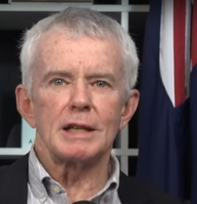 In the 3 minute video below, One Nation Senator Malcolm Roberts calls upon all patriotic Australians to attend the "Australia Unites" protests starting 12pm tomorrow, Saturday 13 September in all of our capital cities. I include further below "Watch how Pauline Hanson HUMILIATES Albanese & Labour MPs in Australia Parliament On LIVE TV!" Pauline Hansen rightly condemns the Albanese/Green government for driving up the cost of living and causing many Australians to become homeless as a consequence of their record high immigration. However this speech is somewhat marred by her condemnation of Australians protesting for Palestine. Whilst, last Sunday 31 March a group of provocateurs, claiming to be supporters of Palestine, attempted to stop the March for Australia, I don't believe they represent those Australians who support Palestine. Beneath Malcolm's video, I urged him to contact NSW Libertarian MLC, John Ruddick who attends protests for Palestine in addition to protests against high immigration.
In the 3 minute video below, One Nation Senator Malcolm Roberts calls upon all patriotic Australians to attend the "Australia Unites" protests starting 12pm tomorrow, Saturday 13 September in all of our capital cities. I include further below "Watch how Pauline Hanson HUMILIATES Albanese & Labour MPs in Australia Parliament On LIVE TV!" Pauline Hansen rightly condemns the Albanese/Green government for driving up the cost of living and causing many Australians to become homeless as a consequence of their record high immigration. However this speech is somewhat marred by her condemnation of Australians protesting for Palestine. Whilst, last Sunday 31 March a group of provocateurs, claiming to be supporters of Palestine, attempted to stop the March for Australia, I don't believe they represent those Australians who support Palestine. Beneath Malcolm's video, I urged him to contact NSW Libertarian MLC, John Ruddick who attends protests for Palestine in addition to protests against high immigration. 
 This article describes and analyses Senator Hanson Young’s tactics in a Senate debate in Australia surrounding a motion proposed by Senator Malcolm Roberts of One Nation to establish an inquiry into the economic impacts of high immigration levels. The motion specifically focused on objective economic metrics such as home prices, rental prices, wage growth, inflation, labour productivity, and the accuracy of government immigration projections.
This article describes and analyses Senator Hanson Young’s tactics in a Senate debate in Australia surrounding a motion proposed by Senator Malcolm Roberts of One Nation to establish an inquiry into the economic impacts of high immigration levels. The motion specifically focused on objective economic metrics such as home prices, rental prices, wage growth, inflation, labour productivity, and the accuracy of government immigration projections. An ABC program actually dealing with immigration statistics is fairly rare. But it seems that even some right-wing pro-growth commentators have been raising concern about the statistic that 1544 new migrants are arriving every day. "1544 people who need housing". The IPA, normally a fan of population growth, has suggested that "excessive migration has pummelled Australia's economic productivity".
An ABC program actually dealing with immigration statistics is fairly rare. But it seems that even some right-wing pro-growth commentators have been raising concern about the statistic that 1544 new migrants are arriving every day. "1544 people who need housing". The IPA, normally a fan of population growth, has suggested that "excessive migration has pummelled Australia's economic productivity".  If politicians don’t include immigration numbers in their platforms, how can voters make their voices heard? Established theory explains why the pressure for faster population growth, driven by a minority that benefits commercially, is much more effective than the pressure against population growth from a majority that bears the costs.
If politicians don’t include immigration numbers in their platforms, how can voters make their voices heard? Established theory explains why the pressure for faster population growth, driven by a minority that benefits commercially, is much more effective than the pressure against population growth from a majority that bears the costs.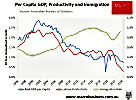 Outfits like the Grattan Institute argue that Australia needs to maintain a high immigration policy to maximise productivity growth. Their analysis consistently overlooks the empirical evidence showing that Australia’s productivity growth declined as immigration surged.
Outfits like the Grattan Institute argue that Australia needs to maintain a high immigration policy to maximise productivity growth. Their analysis consistently overlooks the empirical evidence showing that Australia’s productivity growth declined as immigration surged. In this video, ABC economics journalist Alan Kohler succumbs to YIMBY propaganda, presenting a mathematical problem in a fundamentally flawed way by omitting a crucial factor: immigration. This oversight renders the analysis not only incomplete but absurd, highlighting the importance of considering all variables in any economic equation.
In this video, ABC economics journalist Alan Kohler succumbs to YIMBY propaganda, presenting a mathematical problem in a fundamentally flawed way by omitting a crucial factor: immigration. This oversight renders the analysis not only incomplete but absurd, highlighting the importance of considering all variables in any economic equation. "
" All Australian mainstream media outlets push the idea that we must have rapid population growth in Australia and that this must be sourced by increasing rates of immigration. Whilst the mass media never shuts up about this, they are very repressive about any contrary opinion, although people are really angry about the increasingly obvious costs in all this, and they seek ways to express themselves.
All Australian mainstream media outlets push the idea that we must have rapid population growth in Australia and that this must be sourced by increasing rates of immigration. Whilst the mass media never shuts up about this, they are very repressive about any contrary opinion, although people are really angry about the increasingly obvious costs in all this, and they seek ways to express themselves.
 Australian Bureau of Statistics’ net overseas migration data released today shows the nation’s migration intake remains out-of-control.
Australian Bureau of Statistics’ net overseas migration data released today shows the nation’s migration intake remains out-of-control.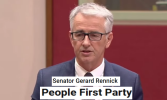 Exercising his independence since leaving the Liberal Party, Senator Rennick, (
Exercising his independence since leaving the Liberal Party, Senator Rennick, ( This discussion covers every important base on the push and pull factors for mass migration and the problems that ensue for the receiving populations on which it is imposed by elites. It is worth a library of books on the subject. Also, on Tommy Robinson, a surprising analysis.
This discussion covers every important base on the push and pull factors for mass migration and the problems that ensue for the receiving populations on which it is imposed by elites. It is worth a library of books on the subject. Also, on Tommy Robinson, a surprising analysis. Funny and interesting delivery. "Australia has spent several months promoting and holding a referendum on the Voice for Indigenous Australians - all the while the Housing Crisis is destroying millions of Australians' Lives. This video highlights the critical issues that are destroying the Australian Housing Market which must be voted on now (with a referendum.)" (Bikos Konstantinos)
Funny and interesting delivery. "Australia has spent several months promoting and holding a referendum on the Voice for Indigenous Australians - all the while the Housing Crisis is destroying millions of Australians' Lives. This video highlights the critical issues that are destroying the Australian Housing Market which must be voted on now (with a referendum.)" (Bikos Konstantinos) Australia’s population of 26.5m grew at the rate of 2.2% (year ending March 2023.) At 2.2% growth rate our current population would increase to 30m within 10 years and double in 31.85 yrs and would reach 150m by 2103, within the life-expectancy of a child born today. Less than 25% of that 2.2 rate of population growth was due to natural increase. Without the 454,361 migration, we would have grown at about 0.55%.
Australia’s population of 26.5m grew at the rate of 2.2% (year ending March 2023.) At 2.2% growth rate our current population would increase to 30m within 10 years and double in 31.85 yrs and would reach 150m by 2103, within the life-expectancy of a child born today. Less than 25% of that 2.2 rate of population growth was due to natural increase. Without the 454,361 migration, we would have grown at about 0.55%. A new report confirms beyond doubt that rapid population growth is the main cause of Australia’s housing affordability crisis, notes Sustainable Population Australia (SPA). While interest rates and government policies influence short-term trends in house prices, it is population growth that has driven house price inflation long-term.
A new report confirms beyond doubt that rapid population growth is the main cause of Australia’s housing affordability crisis, notes Sustainable Population Australia (SPA). While interest rates and government policies influence short-term trends in house prices, it is population growth that has driven house price inflation long-term. Attempts by a Queensland coal mining company to import foreign labour has been condemned by the Mining & Energy Union.Sojitz Blue has applied to import coal mineworkers from overseas whilst simultaneously offering current workers substandard work contracts and delaying negotiations for an enterprise agreement.The company operates the Gregory Crinum and Meteor Down South (MDS) coal mines near Emerald in Queensland and employs 350 workers.
Attempts by a Queensland coal mining company to import foreign labour has been condemned by the Mining & Energy Union.Sojitz Blue has applied to import coal mineworkers from overseas whilst simultaneously offering current workers substandard work contracts and delaying negotiations for an enterprise agreement.The company operates the Gregory Crinum and Meteor Down South (MDS) coal mines near Emerald in Queensland and employs 350 workers. Any new inquiry into Australia’s migration program needs to assess the full costs and benefits of population growth, especially the costs to our environment and the risks of collapse. I wish I had a dollar for every pro-population-increase article I have read that begins by telling the reader that Australia is a nation of immigrants, with some 25% born overseas and about 50% with at least one parent born overseas.
Any new inquiry into Australia’s migration program needs to assess the full costs and benefits of population growth, especially the costs to our environment and the risks of collapse. I wish I had a dollar for every pro-population-increase article I have read that begins by telling the reader that Australia is a nation of immigrants, with some 25% born overseas and about 50% with at least one parent born overseas.
 There is not much comparison between the situation of the multi-millionaire tennis player Novak Djokovic and his fellow detainees in the Park Hotel, Carlton (in Victoria, Australia.) Petitioners for the release of the long term detainees and those for Djokovic have coincided over the last day but probably have little in common.
There is not much comparison between the situation of the multi-millionaire tennis player Novak Djokovic and his fellow detainees in the Park Hotel, Carlton (in Victoria, Australia.) Petitioners for the release of the long term detainees and those for Djokovic have coincided over the last day but probably have little in common.  India is in a terrible state due to the pandemic, a situation largely the result of gross mismanagement by the government. The spread of the virus was difficult to control because of high-density cities that made lock-downs extremely difficult for residents, and safe separation impossible. A highly infectious new variant may also be a driver, but there are other factors, including an underfunded health service, and a severe shortage of doctors. India needs about 600,000 more doctors, just to meet the WHO recommendations for doctor to patient ratio. Unfortunately, the situation is getting worse. A study by the Indian Journal of public health found that, because of population growth, India will need another 2 million doctors by 2030.
India is in a terrible state due to the pandemic, a situation largely the result of gross mismanagement by the government. The spread of the virus was difficult to control because of high-density cities that made lock-downs extremely difficult for residents, and safe separation impossible. A highly infectious new variant may also be a driver, but there are other factors, including an underfunded health service, and a severe shortage of doctors. India needs about 600,000 more doctors, just to meet the WHO recommendations for doctor to patient ratio. Unfortunately, the situation is getting worse. A study by the Indian Journal of public health found that, because of population growth, India will need another 2 million doctors by 2030. 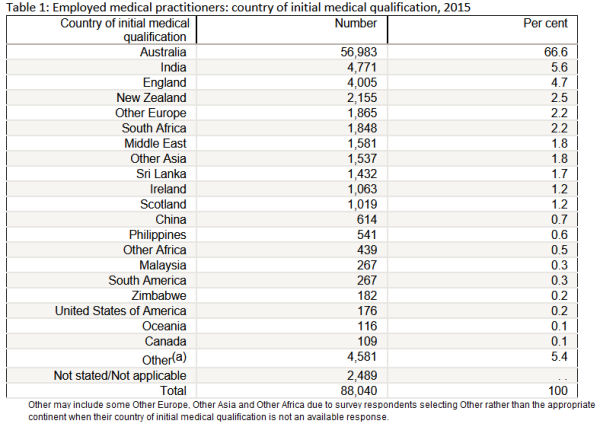

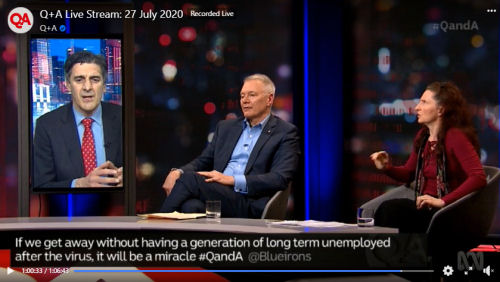
 Previous research has shown a wide split between elite and non-elite opinion on topics such as cultural diversity, globalisation and immigration. Media professionals and most politicians share these elite views, but large swathes of the electorate do not. The current findings of the survey conducted late in 2018 by The Australian Population Research Institute (TAPRI) on attitudes to immigration and population growth confirm this. They show that the split between elite and non-elite opinion is mirrored in the divisions between voters who are university graduates and voters who are not. This is logical as most elites are now recruited from the graduate class. The gap is wide. Overall 50% of voters want a reduction in immigration. But this proportion rises to 60% of non-graduates while only 33% of graduates agree. (The October/November 2018 TAPRI survey Katharine Betts and Bob Birrell.)
Previous research has shown a wide split between elite and non-elite opinion on topics such as cultural diversity, globalisation and immigration. Media professionals and most politicians share these elite views, but large swathes of the electorate do not. The current findings of the survey conducted late in 2018 by The Australian Population Research Institute (TAPRI) on attitudes to immigration and population growth confirm this. They show that the split between elite and non-elite opinion is mirrored in the divisions between voters who are university graduates and voters who are not. This is logical as most elites are now recruited from the graduate class. The gap is wide. Overall 50% of voters want a reduction in immigration. But this proportion rises to 60% of non-graduates while only 33% of graduates agree. (The October/November 2018 TAPRI survey Katharine Betts and Bob Birrell.) Amazing isn’t it? The federal government sets immigration policy. And yet the immigration minister can’t even answer the most simple of questions.
Amazing isn’t it? The federal government sets immigration policy. And yet the immigration minister can’t even answer the most simple of questions.

Recent comments